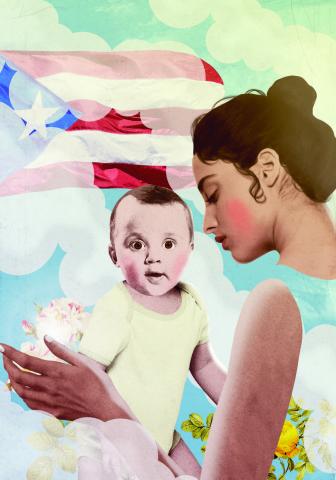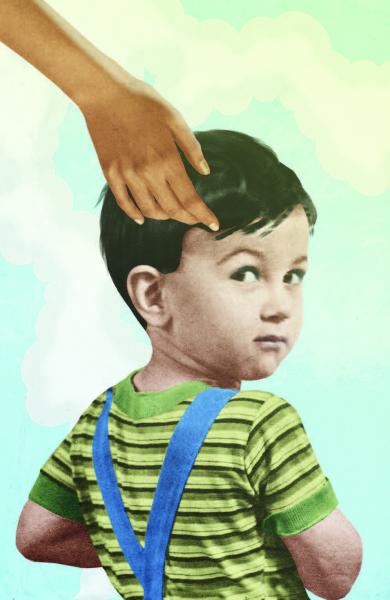Secure Attachment Parenting

By Ann Wlazelek - Illustration by Laurindo Feliciano
Children who feel safe and secure with their mother by their first birthday have a better chance of growing up happy, healthy and better prepared for school, experts say. And, studies show, mothers can foster such a “secure attachment” by sensing and responding to their infants’ needs for comfort or encouragement with a sweet tone of voice and affectionate comments.
But in racially diverse and low-income families, a mother’s sensitivity does not appear to be a key predictor of secure attachment, according to research by Susan S. Woodhouse, associate professor of Counseling Psychology at Lehigh University. Woodhouse is challenging some of those long-held beliefs and exploring the early roots of mental health and educational disparities in a five-year, federally funded research project.
Prior studies examined primarily white, middle-income families. When Woodhouse started looking at moms of different racial and ethnic backgrounds who had little money or help, she found many moms whose parenting styles appeared insensitive, yet still made their babies feel safe and secure.
“Clearly, there is a gap in our understanding of what parenting behaviors really make the most difference in promoting a secure attachment,” she said. To find answers and close the gap, Woodhouse was awarded a $2.1 million grant from the National Institute of Child Health and Human Development, one of the federal government’s National Institutes of Health.
Her grant, titled Caregiving, Attachment, and Regulation of Emotion, or CARE, will observe 200 primarily low-income women and their infants at 6 months and 12 months of age to determine what behaviors lead to a safe and secure attachment and what actions detract from it.
“We hope to learn what Mom behaviors make the most difference in predicting baby outcomes,” said Woodhouse, the study’s principal investigator. “If we want interventions that work when there are limited resources, we want to focus on what matters most.”
One of the reasons Woodhouse became so intrigued with this field of study is personal. In addition to being the mother of a 7-year-old daughter, Woodhouse was considered a “fussy baby” by her own mother. Woodhouse said her mother spoke only Spanish when she immigrated to the United States from Madrid and felt isolated.
“Hearing my mom talk about the lack of support she faced made me want to reach out to other moms,” she said.
The study began in March 2012, when Woodhouse was on the faculty at Pennsylvania State University, and months later followed her to Lehigh, where she expects to finish the project by February 2017. With more than 100 moms and babies so far enrolled, Woodhouse has begun to analyze the data.
She is concentrating on what appeared to work best in earlier research with a smaller group: the simple act of a mom holding her child “chest-to-chest” to calm the infant’s crying, even if the mom didn’t do it every time her child cried.
“My new discovery is the key importance of chest-to-chest soothing when infants cry,” Woodhouse said. “Even if a mother is making a lot of mistakes and being insensitive along the way, as long as she finally relents and comes through in the end by soothing the baby chest-to-chest, that baby will be secure. She doesn’t even need to do it every time. As long as she does it at least 50 percent of the time, that baby will still be secure.”
In fact, mothers can compensate for not soothing the child chest-to chest at least half of the time the child cries. Babies can still feel secure if the moms display what Woodhouse and staffers call “calm connectedness.” For example, babies were secure if the moms made themselves available to look at their child when their babies were looking at them or carried their babies on their hip while doing other things in the house or garden.
CARE also is assessing some parent behaviors Woodhouse found in prior research that worked against a secure attachment. Woodhouse found some year-old infants were unable to feel secure after their mothers had purposely scared them by yelling, threatening to leave or lifting them repeatedly high into the air. In one example, Woodhouse said, a mother screamed “boo” to try to stop the child from crying.
Being able to find security and contentment in the first year of life is important, experts say, because it provides a basis for future relationships. Insecurity in infants, if not altered, can lead to poor behavior, problems with school readiness and mental-health problems.
"As we figure out what matters most for babies, we can develop interventions that will build on those existing strengths.”
Dr. Susan Woodhouse, Counseling Psychology Professor
Woodhouse and her research team have been enrolling women at community events, housing projects, child-care centers and clinics. Research team members discuss the study and hand out brochures to anyone who might qualify. They tell moms the research focuses on “how mothers and babies deal with everyday feelings and stress that are a normal part of raising healthy children.” Participants must have a child 6 months of age or younger who is not yet crawling.
 Moms and babies are tested and observed in their homes and in a lab-playroom, which offers a comfortable couch, age-appropriate toys and two cameras mounted near ceiling corners.
Moms and babies are tested and observed in their homes and in a lab-playroom, which offers a comfortable couch, age-appropriate toys and two cameras mounted near ceiling corners.
At the first two-hour visit, when the baby is 6 months old, staffers check heart rates and swab mouths for the hormone cortisol to assess stress levels of the mother and baby during normal tasks, such as strapping a child into a car seat.
By watching how babies’ cortisol level goes up after a simple stressor and then how quickly this stress hormone goes back to normal, Woodhouse can gauge whether a good mother-baby relationship buffers children from the negative effects of stress. Because babies’ heart-rate variability is an important marker
of infant emotion regulation, electrocardiogram (EKG) wires are attached to the mother and child and tucked into a backpack or vest to not hamper movement during mother-baby interactions. Being able to adapt to stress and regulate emotions is key in later mental health and school readiness.
Staffers also observe behavior in the family home three times over two weeks by videotaping the mother and child during everyday activities. Each session lasts 30 minutes. When the baby is 12 months old, the mother brings him or her back to the lab for another two-hour testing and observation session. That’s followed by two at-home observations, each 1.5 to 2 hours in duration, a week apart. CARE staffers are trained in how to videotape and rate the behaviors they observe.
After all the testing is completed, the mothers are offered social services. They are also offered parenting support through a program called “Circle of Security” that Woodhouse considers one of the most promising interventions available. The course uses a video to stimulate learning and discussion about infant needs. By playing a game called “Name that Need,” mothers are taught whether a baby needs to be soothed or encouraged to explore. In addition, mothers are supported in exploring how to better meet their babies’ needs.
Woodhouse is a part of a community-research partnership called Parents and Children Together (PACT). As a PACT member, she receives guidance and suggestions from a PACT Community Advisory Board, which is made up of community leaders and grass-roots community members, about how to best engage the community. It was the Community Advisory Board’s idea, for example, to give the moms some parenting support at the final visit.
“They wanted to make sure each mom would immediately get something positive to support her parenting, in addition to contributing to building knowledge about mothers and babies in the community,” said Woodhouse, who also regularly reports back to community members about her findings “so that the results belong to the community, not just to the scientific community.”
Denise Sturnes, project coordinator and lab director, said she’s seen mothers enter the study not knowing what to expect and leaving with a greater awareness of how to connect with their infants. “It’s been rewarding for me to see the transformation,” she said of moms who learned that their children were not trying to bother or irritate them, but in need of comfort and love.
Woodhouse said she understands that many other factors can influence a child’s development, including behaviors of the father, grandparents and other guardians. However, mothers remain the primary caregivers of children around the world.
“For the first time, we are starting to see some of the hidden strengths that exist in low-income moms,” Woodhouse said. “As we figure out what matters most for babies, we can develop interventions that will build on those existing strengths. We can help moms who are struggling look more like the successful moms within their own communities instead of trying to make them look like other moms from other places.”
Kristin A. Buss, professor of psychology and director of graduate training at Penn State who directs PACT, considers Woodhouse’s work “innovative.”
“First, the work is innovative in the focus on specific aspects of mother’s behavior that help babies form secure attachment,” Buss said. “The conceptual idea is that when mothers, regardless of cultural variations which have historically been viewed as maladaptive or less sensitive, engage in behaviors that help the baby calm, even if that behavior doesn’t look pretty, it is effective. The second thing that sets CARE apart is that when families are done with the study they enter an intervention phase.”
Buss said the impact is not likely to happen overnight, but hopefully families in the study will see benefits from the lessons, and PACT members can help disseminate the findings in the community.